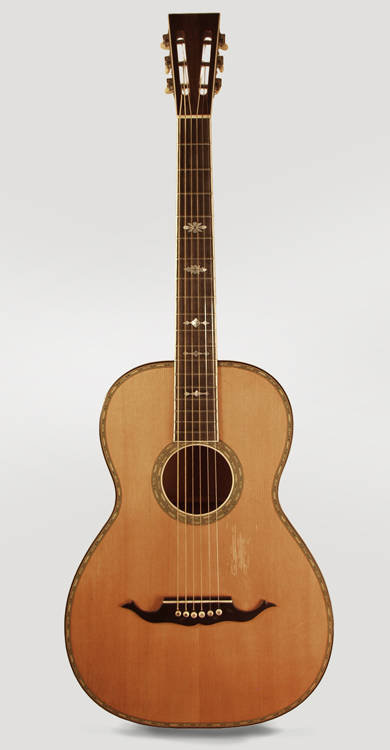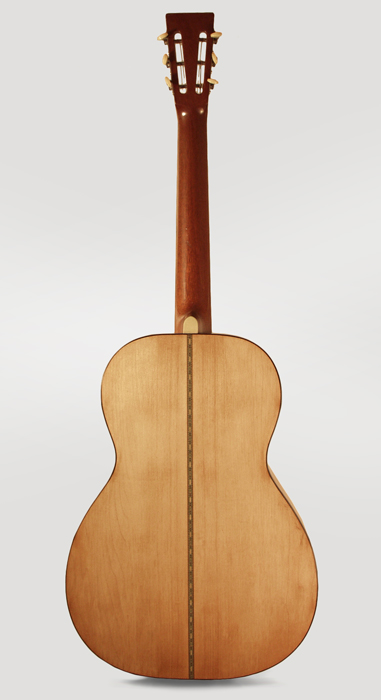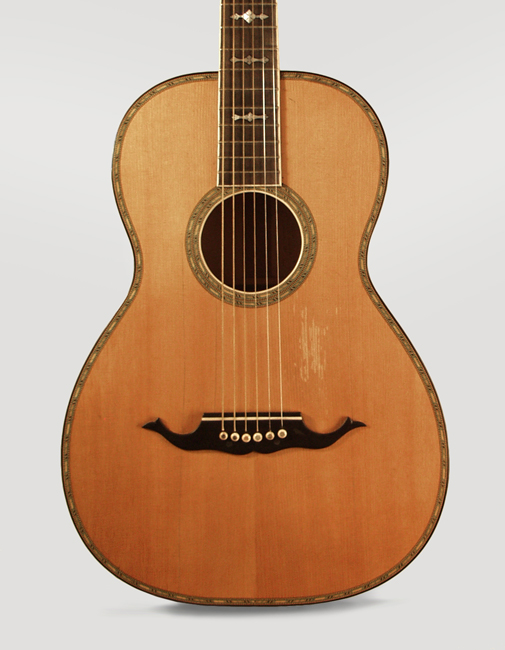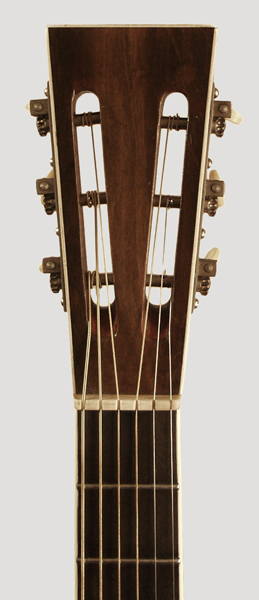Grand Concert Flat Top Acoustic Guitar, labeled Iucci , c. 1925
This item has been sold.
Item # 6849
Prices subject to change without notice.
Grand Concert Model Flat Top Acoustic Guitar, labeled Iucci, c. 1925, made in New York City, natural finish, maple back and sides, spruce top; mahogany neck with ebonized fingerboard, black hard shell case.
This is a most fascinating and historically important guitar, and an extraordinarily fine and well preserved piece of American guitar history. New York City of the 1910's and 1920's was teeming with immigrants, including large numbers recently arrived from Italy. The first quarter of the 20th Century saw the establishment of what has been referred to as "The Italian Guild", a set of loosely affiliated small instrument workshops and music stores operated in the city by immigrant luthiers including Antonio Cerrito, Raphael Ciani, J. Nettuno, Nicolai Turturro, Michael Iucci and others. Some of these craftsmen also appear to have had ties to the Oscar Schmidt Company's instrument factory in nearby Jersey City, NJ, builders of the iconic "Stella" guitars. While often similar in design, the instruments produced in the small Little Italy shops exhibit a much higher level of craftsmanship and original details than Schmidt factory products. Bowlback mandolins were predictably the most popular offering, but the guitars are the prizes today.
This exquisite example of a high-grade New York Italian-made guitar is ink stamped "M. Iucci, Music House, 77 Broome St. N.Y." on the back just off the center strip. Iucci's work was known to be even more flamboyant than many of his peers, and he created many extremely elaborate and beautiful banjos and mandolins in this period. Guitars with his mark are quite rare, however, and we believe based on design and construction details that this particular guitar was made for him by his colleague, Raphael Ciani-uncle and trainer of John D'Angelico. Many particulars of this instrument are virtually identical to known Ciani-labelled instruments. The back and sides are of a clear maple, inlaid profusely with multi-colored wood purfling. The top and back are bound in black celluloid, setting off this patterned edging against the clear maple. The sound hole has a double purfling rosette and the edge is bound in white. The ladder-braced top is fashioned from high-grade spruce topped by an elegant carved 'mustache' bridge. This somewhat whimsical design is often seen often on these instruments, and shared by some higher grade instruments rom the nearby Oscar Schmidt factory. The bridge was secured with two small bolts in addition to the glue-a practice Gibson would later adopt. The bone bridge pins with abalone dots are original and again typical of the higher grade of these instruments. The neck is mahogany, carved to a very comfortable 'C' profile with a lovely thin, sculpted heel with a multi-layer heelcap-all typical of Ciani. The ebonized maple fingerboard is bound in white and sports a shaped pearl inlay pattern used on several generations of fancy New York-made guitars from the early 20th century. The headstock is bound in white with a walnut overlay, and mounts original Waverly open plate tuners.
This guitar is quite a large instrument for its day, measuring 14 3/4" across the lower bout. The scale length is long at 26", typical of these larger Italian pieces. These were not made for dainty classicists, like period Martins-they were designed for volume and projection, often in ensemble settings and intended for steel strings from the start. The itinerant players who would have ordered a guitar like this were employed in cafes, restaurants and on the vaudeville stage and required a powerful tone with the punch to cut through the din. This maple guitar is an exceptionally fine example of the higher grades of this type of guitar, not only a showpiece to look at but a very well-made and good sounding instrument. We've examined a number of these New York-made guitars over the years and this one is absolutely one of the finest in both condition and sound. The maple body shades it into a pre-archtop realm of projection-the tone is clear, powerful and rich, with a lot of cut when played in 1920's style. If as we believe this guitar is a product of the Ciani shop, it was built under the supervision of John D'Angelico and may well embody some of his early ideas about guitar design and construction. This exact style of maple guitar is a rare piece; only two other examples are known. One of these appeared in the 2011 exhibit entitled "Guitar Heroes: Legendary Craftsmen From Italy To New York" at the Metropolitan Museum, listed as "attributed to John De'Angelico". This is a wonderful and extremely rare example of a rich if often overlooked American guitar tradition.
Overall length is 40 1/4 in. (102.2 cm.), 14 3/4 in. (37.5 cm.) wide at lower bout, and 3 7/8 in. (9.8 cm.) in depth at side, taken at the end block. Scale length is 26 in. (660 mm.). Width of nut is 1 13/16 in. (46 mm.). This guitar has some light wear and professional repair but remains extremely well preserved. It has had a neck set, and the three long top cracks have been cleanly glued and cleated. The bridge plate/brace has some chip out between several pin holes from string ball wear, but is still fully functional. There is some pickwear to the top below the strings and general light checking and wear overall, but for an instrument of this period carrying such a light finish the degree is minimal. An excellent player as well, a truly unusual and exceptional guitar waiting to be re-discovered for the next 100 years. Excellent Condition.
This is a most fascinating and historically important guitar, and an extraordinarily fine and well preserved piece of American guitar history. New York City of the 1910's and 1920's was teeming with immigrants, including large numbers recently arrived from Italy. The first quarter of the 20th Century saw the establishment of what has been referred to as "The Italian Guild", a set of loosely affiliated small instrument workshops and music stores operated in the city by immigrant luthiers including Antonio Cerrito, Raphael Ciani, J. Nettuno, Nicolai Turturro, Michael Iucci and others. Some of these craftsmen also appear to have had ties to the Oscar Schmidt Company's instrument factory in nearby Jersey City, NJ, builders of the iconic "Stella" guitars. While often similar in design, the instruments produced in the small Little Italy shops exhibit a much higher level of craftsmanship and original details than Schmidt factory products. Bowlback mandolins were predictably the most popular offering, but the guitars are the prizes today.
This exquisite example of a high-grade New York Italian-made guitar is ink stamped "M. Iucci, Music House, 77 Broome St. N.Y." on the back just off the center strip. Iucci's work was known to be even more flamboyant than many of his peers, and he created many extremely elaborate and beautiful banjos and mandolins in this period. Guitars with his mark are quite rare, however, and we believe based on design and construction details that this particular guitar was made for him by his colleague, Raphael Ciani-uncle and trainer of John D'Angelico. Many particulars of this instrument are virtually identical to known Ciani-labelled instruments. The back and sides are of a clear maple, inlaid profusely with multi-colored wood purfling. The top and back are bound in black celluloid, setting off this patterned edging against the clear maple. The sound hole has a double purfling rosette and the edge is bound in white. The ladder-braced top is fashioned from high-grade spruce topped by an elegant carved 'mustache' bridge. This somewhat whimsical design is often seen often on these instruments, and shared by some higher grade instruments rom the nearby Oscar Schmidt factory. The bridge was secured with two small bolts in addition to the glue-a practice Gibson would later adopt. The bone bridge pins with abalone dots are original and again typical of the higher grade of these instruments. The neck is mahogany, carved to a very comfortable 'C' profile with a lovely thin, sculpted heel with a multi-layer heelcap-all typical of Ciani. The ebonized maple fingerboard is bound in white and sports a shaped pearl inlay pattern used on several generations of fancy New York-made guitars from the early 20th century. The headstock is bound in white with a walnut overlay, and mounts original Waverly open plate tuners.
This guitar is quite a large instrument for its day, measuring 14 3/4" across the lower bout. The scale length is long at 26", typical of these larger Italian pieces. These were not made for dainty classicists, like period Martins-they were designed for volume and projection, often in ensemble settings and intended for steel strings from the start. The itinerant players who would have ordered a guitar like this were employed in cafes, restaurants and on the vaudeville stage and required a powerful tone with the punch to cut through the din. This maple guitar is an exceptionally fine example of the higher grades of this type of guitar, not only a showpiece to look at but a very well-made and good sounding instrument. We've examined a number of these New York-made guitars over the years and this one is absolutely one of the finest in both condition and sound. The maple body shades it into a pre-archtop realm of projection-the tone is clear, powerful and rich, with a lot of cut when played in 1920's style. If as we believe this guitar is a product of the Ciani shop, it was built under the supervision of John D'Angelico and may well embody some of his early ideas about guitar design and construction. This exact style of maple guitar is a rare piece; only two other examples are known. One of these appeared in the 2011 exhibit entitled "Guitar Heroes: Legendary Craftsmen From Italy To New York" at the Metropolitan Museum, listed as "attributed to John De'Angelico". This is a wonderful and extremely rare example of a rich if often overlooked American guitar tradition.
Overall length is 40 1/4 in. (102.2 cm.), 14 3/4 in. (37.5 cm.) wide at lower bout, and 3 7/8 in. (9.8 cm.) in depth at side, taken at the end block. Scale length is 26 in. (660 mm.). Width of nut is 1 13/16 in. (46 mm.). This guitar has some light wear and professional repair but remains extremely well preserved. It has had a neck set, and the three long top cracks have been cleanly glued and cleated. The bridge plate/brace has some chip out between several pin holes from string ball wear, but is still fully functional. There is some pickwear to the top below the strings and general light checking and wear overall, but for an instrument of this period carrying such a light finish the degree is minimal. An excellent player as well, a truly unusual and exceptional guitar waiting to be re-discovered for the next 100 years. Excellent Condition.




